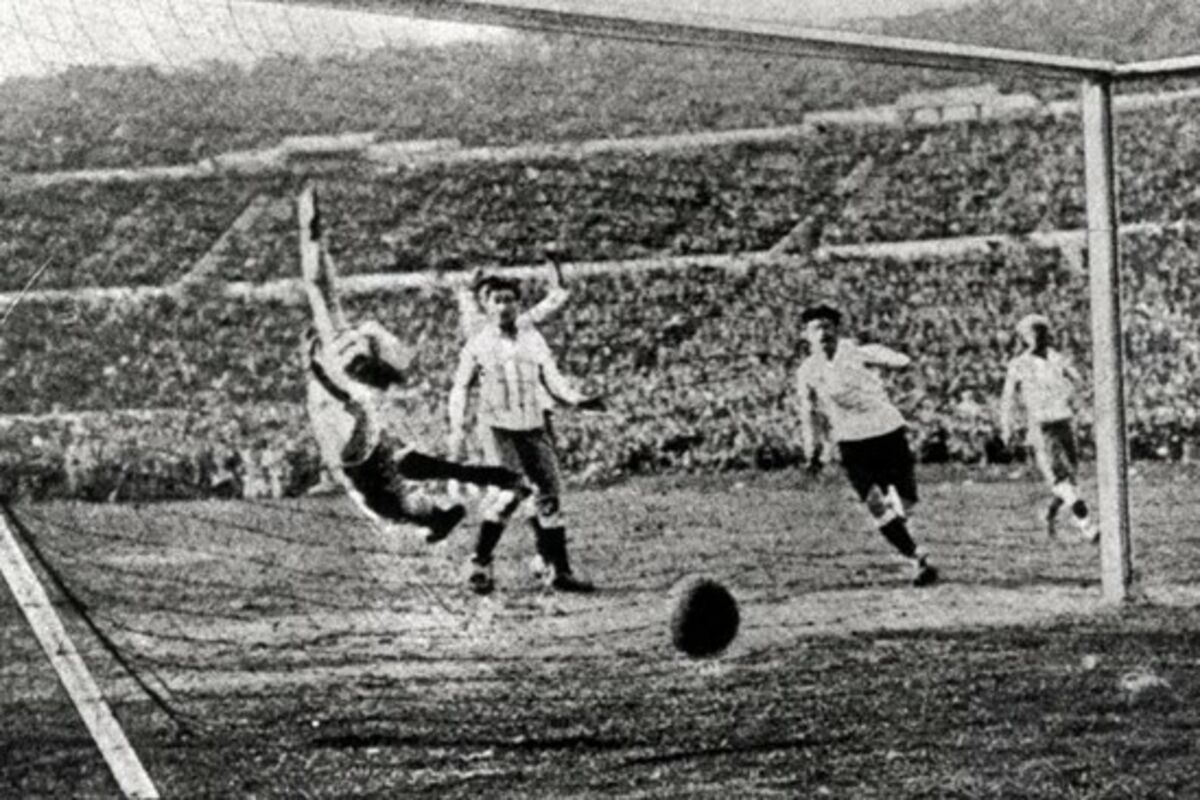First Football World Cup, held in 1930, sets the stage for this enthralling narrative! Journey back to a time when global communication was limited, and international travel was an adventure in itself. We’ll uncover the political backdrop, the thrilling matches, and the surprising underdog story that defined this inaugural event, leaving a lasting legacy on the beautiful game.
Imagine a world without instant replays or sophisticated stadium technology. Picture teams traveling across oceans, facing unforeseen challenges, and playing under the gaze of passionate, yet sometimes unruly, crowds. This is the story of the first World Cup, a tournament that not only crowned a champion but also laid the foundation for the global phenomenon we know today. We’ll delve into the individual teams’ journeys, the key players who etched their names in history, and the unforgettable moments that shaped this pivotal competition.
Get ready for a captivating look into the past, a journey through time to witness the birth of a sporting legend.
Historical Context of the First World Cup: First Football World Cup
The 1930 FIFA World Cup, held in Uruguay, marked a pivotal moment in global sports history. It unfolded against a backdrop of significant political and social upheaval, shaping the tournament’s unique character and leaving a lasting legacy. The event transcended mere sporting competition, reflecting the complex international landscape of the era.
The Political Climate of 1930
The early 1930s were a period of global tension and uncertainty. The aftermath of World War I had left many nations economically strained and politically unstable. The Great Depression was beginning to grip the world, causing widespread economic hardship and social unrest. Rising nationalism and the threat of fascism were palpable in Europe, casting a long shadow over international relations.
Despite these challenges, the international football community found common ground in the pursuit of a global tournament, demonstrating a surprising capacity for cooperation in a fractured world. The choice of Uruguay as the host nation, a small South American country, reflected a desire to showcase the growing global reach of football, even amid significant political turmoil.
The Social Impact on Uruguay
Hosting the first World Cup had a profound impact on Uruguay. The tournament boosted national pride and showcased the country’s capabilities on the world stage. Uruguay, a relatively small nation, gained significant international recognition and prestige. The influx of visitors and media attention provided a substantial economic boost, although the full economic impact is difficult to quantify given the limitations of historical data.
The event also served as a unifying force within Uruguay, bringing together people from different social backgrounds in a shared national celebration. The legacy of this tournament remains a significant part of Uruguayan national identity.
Challenges in Organizing a Global Tournament
Organizing the first World Cup presented numerous challenges, primarily due to limitations in global communication and transportation. International travel was time-consuming and expensive, making it difficult for teams from distant nations to participate. Communication between organizing committees and participating nations was slow and often unreliable, relying heavily on telegrams and mail. The lack of standardized rules and regulations across different football associations also posed a significant hurdle.
Overcoming these obstacles required considerable diplomacy and resourcefulness from the organizers, highlighting the pioneering spirit of the event.
Timeline of Key Events Leading to the 1930 World Cup
The process of organizing the first World Cup was a lengthy and complex undertaking. Key events leading to the tournament include:
- 1928: FIFA officially approves the plan for a World Cup tournament.
- 1929: Uruguay is selected as the host nation, partly to celebrate their centenary and their recent Olympic football victories.
- Early 1930: Invitations are sent to national football associations around the world. Many European nations struggle with the cost and travel time involved.
- May-June 1930: Teams arrive in Uruguay, many facing significant logistical hurdles.
- July 13, 1930: The first match of the World Cup is played.
Participating Nations and Qualification Methods
The qualification process for the first World Cup varied significantly between continents, reflecting the uneven development of football globally.
| Nation | Confederation | Qualification Method | Notable Players |
|---|---|---|---|
| Uruguay | CONMEBOL | Host Nation | José Nasazzi, Héctor Castro |
| Argentina | CONMEBOL | Invited | Guillermo Stábile |
| Chile | CONMEBOL | Invited | Guillermo Riveros |
| Bolivia | CONMEBOL | Invited | Casimiro Torrico |
| Paraguay | CONMEBOL | Invited | Aurelio González |
| Peru | CONMEBOL | Invited | Plácido Galindo |
| United States | CONCACAF | Invited | Bill Cagle |
| Mexico | CONCACAF | Invited | Juan Carreño |
| Belgium | UEFA | Invited | Robert Coppée |
| France | UEFA | Invited | Marcel Pinelli |
| Romania | UEFA | Invited | Adalbert Deșiu |
| Yugoslavia | UEFA | Invited | Milovan Jakšić |
The Legacy and Impact of the First World Cup

The inaugural FIFA World Cup in 1930, though modest by today’s standards, left an indelible mark on the global landscape of football. Its impact reverberated through the sport, shaping its rules, governance, and global popularity in ways that continue to resonate nearly a century later. The tournament’s legacy extends far beyond the final whistle, influencing the very fabric of international football as we know it.
The First World Cup’s Influence on Football Development
The 1930 World Cup served as a crucial catalyst for the professionalization and standardization of football. Prior to the tournament, the sport’s rules and playing styles varied significantly across different countries. The tournament’s success highlighted the need for a unified set of regulations, prompting FIFA to actively pursue greater consistency in the game’s laws. This drive towards standardization fostered a more competitive and engaging international competition, encouraging national teams to adopt more structured training regimes and professional approaches to the game.
The increased global attention on the sport also spurred investment in infrastructure and training facilities in many participating nations.
The Tournament’s Impact on Global Popularity, First football world cup
The 1930 World Cup, despite its limitations in terms of participation and broadcasting reach, significantly boosted the sport’s global appeal. While radio broadcasts brought the excitement of the matches to listeners worldwide, the tournament’s coverage in newspapers and magazines helped establish football as a truly international spectacle. The success of the event inspired other nations to develop their own national teams and invest in the growth of the sport at home.
This initial surge in popularity laid the groundwork for the World Cup’s exponential growth in subsequent decades, transforming it into the globally watched event it is today.
Changes in Football Rules and Regulations Following the Tournament
The experience of organizing and running the first World Cup highlighted several areas where clarification and standardization of football rules were needed. The tournament spurred discussions and revisions within FIFA, leading to more precise definitions of fouls, offsides, and other key aspects of the game. While specific rule changes weren’t immediately dramatic, the process of codifying and refining the rules began in earnest, leading to the more formalized and internationally consistent rulebook we have today.
The focus on fair play and consistent officiating, born from the experiences of the 1930 tournament, became a cornerstone of international football governance.
Comparison of the 1930 World Cup with Subsequent World Cups
The 1930 World Cup stands in stark contrast to its modern counterparts. The tournament featured only 13 teams, primarily from the Americas and Europe, a far cry from the 32 teams participating in recent World Cups. The level of media coverage and technological advancements were significantly less advanced. Matches were often played in basic stadiums, lacking the sophisticated infrastructure and technological support of modern arenas.
Furthermore, the global reach and cultural impact of the 1930 event were limited compared to the worldwide spectacle that the World Cup has become. However, the 1930 tournament laid the foundation for the massive global event it evolved into. It demonstrated the potential of a global football competition, setting the stage for the expansion and refinement seen in subsequent tournaments.
Contribution to the Development of International Football Governance
The 1930 World Cup was pivotal in strengthening FIFA’s role as the governing body of international football. The successful organization of the tournament solidified FIFA’s authority and legitimacy on the world stage. The challenges faced during the tournament’s planning and execution highlighted the need for a more robust and centralized international football governing body. The experience gained from the 1930 World Cup provided valuable lessons in managing a large-scale international event, enabling FIFA to refine its organizational structure and develop more effective governance mechanisms for future tournaments.
This strengthened FIFA’s position as the leading authority in football, shaping the future of international competitions and the sport’s global trajectory.
The 1930 World Cup, despite its challenges, stands as a testament to the enduring power of sport to unite nations. From the initial hurdles of organizing a truly global tournament to the unexpected triumph of Uruguay, the story is one of overcoming adversity, celebrating athletic prowess, and laying the groundwork for the global spectacle we know today. This first tournament wasn’t just about the matches played; it was about forging connections across continents and planting the seeds for football’s global dominance.
Its legacy continues to resonate in every World Cup that follows, a reminder of the humble beginnings of a sporting giant.
Expand your understanding about world cup in 1994 with the sources we offer.



